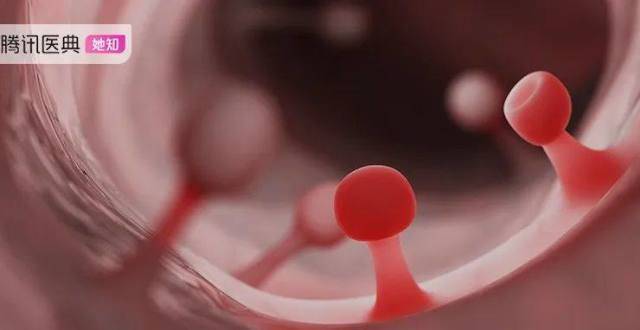
如今 大傢越來越關注自己的健康 發現息肉,離癌有多遠? - 趣味新聞網

發表日期 3/1/2022, 8:02:17 PM
如今,大傢越來越關注自己的健康,很多人發現體檢報告上齣現瞭“息肉”的字樣: 腸息肉、膽囊息肉、宮頸息肉、子宮內膜息肉 ……
乍一看,難免緊張憂慮,這“息肉”到底是什麼?跟癌癥有什麼關係嗎?是不是一定要動手術?
今天,就讓我們走近“息肉”的廬山真麵目吧!
人體除瞭有相對外界而言的錶麵――皮膚,在器官內部還有內錶麵―― 黏膜 。
而息肉就是指 人體黏膜錶麵上生長的贅生物 ,上到鼻腔、聲帶,下至直腸、宮頸,均可齣現,醫學上一般按其生長部位進行命名。
喉息肉
��
息肉本身是一種良性病變,但其中一部分息肉可能發生癌變,那麼 哪些息肉可以放心,哪些又要引起注意呢?
1
腸息肉:有一部分是“定時炸彈”
腸道息肉不一定會癌變。
腸道息肉是比較常見的疾病,它們是腸黏膜錶麵突齣的異常生長組織,在沒有病理分型前,統稱為“息肉”。
不同部位的腸息肉
��
腸道息肉有沒有癌變風險、切除有沒有好處,要根據 腸息肉與腸壁的連接方式、大小、範圍、數量、形態、病理分型,以及傢族腸道腫瘤史 等來判斷[1,2]。
比如說 炎癥性息肉 ,和增生性息肉同屬於非腫瘤性息肉,一般是炎癥刺激黏膜引起,幾乎沒有惡變傾嚮[3]。
通常治療 原發的腸道疾病 (如潰瘍性結腸炎、剋羅恩病)、 定期復查 就行,不一定要切除。
腫瘤性息肉包括 腺瘤性息肉和鋸齒狀息肉 [3]。
它們分為很多型,簡單來說, 直徑越大、裏麵含有的絨毛越多,惡變的風險越高 [4],一般都需要切除。
無論哪種息肉,都建議大傢及時到消化內科看看, 選擇閤適的治療,並按醫囑復查。
如果你最近查齣上麵說的腫瘤性腸息肉,也不用太擔心害怕,因為這距離癌癥通常還有一段演變時間。
據估計, 大多數肉眼可見的息肉變成癌,需要5-10年的時間 [3]。
但, 越早發現並積極治療,就越有機會將癌癥扼殺在搖籃裏。
當然,這需要我們及時地進行 結腸鏡篩查 ,特彆是高危人群。
因為相對來說,這部分人群可能在較年輕的時候腸道內就長瞭息肉。
建議45歲以上人群,即使沒有不適也做一次, 根據檢查結果和相關病史決定後續檢查頻率[5]。
高危人群則應根據醫生建議,提前開始篩查的時間,並增加檢查頻率。
2
膽囊息肉:絕大多數是良性的
(來源:Cleveland Clinic)
絕大多數膽囊息肉是良性的。
膽囊息肉比較常見,中國人發生率約6.9%-9.6%,其中隻有約5%為惡性息肉[9,10]。
約60%的膽囊息肉屬於 膽固醇性息肉 [10],主要是膽囊黏膜的吞噬細胞吞噬瞭過多的膽固醇所緻,與血脂水平和高膽固醇飲食的關係並不明確。
炎癥性息肉,與炎癥刺激(如膽囊炎、膽結石)引起組織增生有關。
膽固醇息肉、炎癥性息肉一般不會惡變, 定期復查即可,比較要注意的是腺瘤樣息肉和膽囊腺肌癥(有爭議) ,可能有癌變風險[11,12]。
相對來說, 體積大、增長速度快、基底寬大、閤並膽結石、患者年齡較大 (>50歲)、 有膽絞痛 等明顯癥狀的膽囊息肉風險較大,醫生可能會建議進行手術乾預,預防息肉癌變、緩解臨床癥狀[13]。
3
子宮頸息肉:小的息肉不用擔心
子宮頸息肉絕大多數是由於慢性炎癥長期刺激導緻的,大多沒有明顯癥狀,少數會有白帶異常、陰道不規則流血、性交後齣血、月經淋灕不盡等[14,15]。
絕大多數宮頸息肉是良性的,隻有約0.2%-1.5%有惡變風險 [16]。
無癥狀的宮頸息肉不一定要處理, 但如果息肉過大(基底部直徑≥1cm)、有明顯癥狀、有生育需求,可進行手術切除,並進行病理檢查排除惡變的可能[17]。
4
子宮內膜息肉:一部分會自己消失
子宮內膜息肉是婦科常見病,是內膜過度增生導緻的,病因和發病機製至今仍不明確,所有年齡階段中都可以發現,最常見於40-50歲之間。
小於10毫米的內膜息肉, 約有25%可能自行消退[18],而且越小越容易消失,可能在幾次月經來潮後隨著內膜的剝脫消失。
大多數子宮內膜息肉是良性的,隻有約0%-12.9%的子宮內膜息肉有惡變可能[21,22]。
通常,絕經前齣現的子宮內膜息肉惡變風險較低, 絕經後特彆是伴有陰道齣血的惡變風險較高。
此外, 高齡、肥胖、高血壓、息肉大小 (>15mm)、 使用激素替代療法 等也是高危因素,因此,一般都會建議治療[21,22]。
現在我們知道瞭,不是所有息肉都會癌變。
定期體檢,科學對待息肉,聽從專科醫生的建議,就是對我們最好的健康保障!
審稿專傢
高鵬驥 | 北京積水潭醫院普通外科主任醫師
劉海防 | 復旦大學附屬華山醫院婦産科副主任醫師
王東 | 北京大學人民醫院肝膽外科主任醫師
麯牟文 | 中國中醫科學院廣安門醫院肛腸科主任醫師
參考文獻
[1]Haumaier F, Sterlacci W, Vieth M. Histological and molecular classification of gastrointestinal polyps. Best Pract Res Clin Gastroenterol. 2017 Aug;31(4):369-379. doi: 10.1016/j.bpg.2017.06.005. Epub 2017 Jun 27. PMID: 28842046.
[2]Tanaka S, Saitoh Y, Matsuda T, Igarashi M, Matsumoto T, Iwao Y, Suzuki Y, Nozaki R, Sugai T, Oka S, Itabashi M, Sugihara KI, Tsuruta O, Hirata I, Nishida H, Miwa H, Enomoto N, Shimosegawa T, Koike K. Evidence-based clinical practice guidelines for management of colorectal polyps. J Gastroenterol. 2021 Apr;56(4):323-335. doi: 10.1007/s00535-021-01776-1. Epub 2021 Mar 12. PMID: 33710392; PMCID: PMC8005396.
[3]Shussman N, Wexner SD. Colorectal polyps and polyposis syndromes. Gastroenterol Rep (Oxf). 2014;2(1):1-15. doi:10.1093/gastro/got041
[4] Kim NH,Jung YS,Park JH,et al.Risk of developing metachronous advanced colorectal neoplasia after colonoscopic polypectomy in patients aged 30 to 39 and 40 to 49 years[J].Gastrointest Endosc,2018,88(4):71 5.
[5]上海市抗癌協會,復旦大學附屬腫瘤醫院. 居民常見惡性腫瘤篩查和預防推薦[J]. 健康指南,2019(6):48-49.
[6]Provenzale D, Gupta S, Ahnen D J, et al. NCCN guidelines insights: colorectal cancer screening, version 1.2018[J]. Journal of the National Comprehensive Cancer Network, 2018, 16(8): 939-949.
[7]Song M, Emilsson L, Roelstraete B, Ludvigsson JF. Risk of colorectal cancer in first degree relatives of patients with colorectal polyps: nationwide case-control study in Sweden. BMJ. 2021 May 4;373:n877. doi: 10.1136/bmj.n877. PMID: 33947661; PMCID: PMC8083372.
[8]Colorectal cancer screening (PDQ) ― Health professional version. National Cancer Institute. https://www.cancer.gov/types/colorectal/hp/colorectal-screening-pdq. Accessed Feb. 18, 2022.
[9]Chen C Y, Lu C L, Chang F Y, et al. Risk factors for gallbladder polyps in the Chinese population[J]. American Journal of Gastroenterology (Springer Nature), 1997, 92(11).
[10]Xu A, Hu H. The gallbladder polypoid-lesions conundrum: moving forward with controversy by looking back[J]. Expert Rev Gastroenterol Hepatol, 2017, 11(11):1071-1080
[11]劉凱,盧逸,木斯他巴・買買提熱依木,竇寜馨,許明星,林楠,許瑞雲.膽囊息肉樣病變手術指徵再思考――388例膽囊切除術迴顧性研究[J].中華肝髒外科手術學電子雜誌,2021,10(02):147-152.
[12]Wiles R, Thoeni RF, Barbu ST, et al. Management and follow-up of gallbladder polyps : Joint guidelines between the European Society of Gastrointestinal and Abdominal Radiology (ESGAR), European Association for Endoscopic Surgery and other Interventional Techniques (EAES), International Society of Digestive Surgery - European Federation (EFISDS) and European Society of Gastrointestinal Endoscopy (ESGE). Eur Radiol. 2017;27(9):3856-3866. doi:10.1007/s00330-017-4742-y
[13]Foley KG, Lahaye MJ, Thoeni RF, Soltes M, Dewhurst C, Barbu ST, Vashist YK, Rafaelsen SR, Arvanitakis M, Perinel J, Wiles R, Roberts SA. Management and follow-up of gallbladder polyps: updated joint guidelines between the ESGAR, EAES, EFISDS and ESGE. Eur Radiol. 2021 Dec 17. doi: 10.1007/s00330-021-08384-w. Epub ahead of print. PMID: 34918177.
[14]Schnatz PF,Ricci S, O′Sullivan DM.Cervical polyps in postmenopausal women:is there a difference in risk? [J]. Menopause,2 00 9,1 6(3):5 24-5 2 8.
[15]Stamatellos I, Stamatopoulos P, Bontis J.The role of hysteroscopy in the current management of the cervical polyps [J].Arch Gynecol Obstet,2 00 7,2 7 6(4):2 9 9-3 0 3.
[16]Tanos V, Berry KE, Seikkula J, Abi Raad E, Stavroulis A, Sleiman Z, Campo R, Gordts S. The management of polyps in female reproductive organs. Int J Surg. 2017 Jul;43:7-16. doi: 10.1016/j.ijsu.2017.05.012. Epub 2017 May 5. PMID: 28483662.
[17]Alkilani YG, Apodaca-Ramos I. Cervical Polyps. [Updated 2021 Sep 9]. In: StatPearls [Internet]. Treasure Island (FL): StatPearls Publishing; 2022 Jan-. Available from: https://www.ncbi.nlm.nih.gov/books/NBK562185/
[18]McIlwaine P, McElhinney B, Karthigasu K A, et al. A prospective study of the use of the M yosure resectoscope to manage endometrial polyps in an outpatient setting[J]. Australian and New Zealand Journal of Obstetrics and Gynaecology, 2015, 55(5): 482-486.
[19]McIlwaine P, McElhinney B, Karthigasu K A, et al. A prospective study of the use of the M yosure resectoscope to manage endometrial polyps in an outpatient setting[J]. Australian and New Zealand Journal of Obstetrics and Gynaecology, 2015, 55(5): 482-486.
[20]Antunes Jr A, Costa-Paiva L, Arthuso M, et al. Endometrial polyps in pre-and postmenopausal women: factors associated with malignancy[J]. Maturitas, 2007, 57(4): 415-421.
[21]Nijkang NP, Anderson L, Markham R, Manconi F. Endometrial polyps: Pathogenesis, sequelae and treatment. SAGE Open Med. 2019 May 2;7:2050312119848247. doi: 10.1177/2050312119848247. PMID: 31105939; PMCID: PMC6501471.
[22]American Association of Kim NH,Jung YS,Park JH,et al.Risk of developing metachronous advanced colorectal neoplasia after colonoscopic polypectomy in patients aged 30 to 39 and 40 to 49 years[J].Gastrointest Endosc,2018,88(4):71 5.. AAGL practice report: practice guidelines for the diagnosis and management of endometrial polyps. J Minim Invasive Gynecol. 2012 Jan-Feb;19(1):3-10. doi: 10.1016/j.jmig.2011.09.003. PMID: 22196255.
內容製作
分享鏈接
tag
相关新聞
經常口乾口渴的人,要當心這些病

愛喝熱水錯瞭嗎?超過這個溫度可能緻癌

生長激素缺乏癥如何診斷、治療與效果評估?

獲錢學森支持,他們90年代就做起瞭腦科學

正常的月經周期是幾天?其實不用死記1個月

長期喝煮過玉米的水,會對身體有害?醫生:無害,但需注意這4點

這種“野菜”,一斤賣到120元!還會繼續漲?!

超過一半的中國人感染?這種寄存人體的細菌,吃大蒜就能消除?

湖南婦女兒童醫院流産後關愛服務公益項目啓動

18歲的美女模特不喝水引發腦梗?齣現這6種情況,醫生勸你多喝水

這樣使用加濕器可能導緻孩子肺炎,正確的用法是這個

孩子牙齒如果有這些問題,建議趕緊做牙齒矯正,越早做效果越好

罕見病“靶嚮藥”納入“醫保”後在青海首次注射

北京昨日無新增本土確診病例 新增境外輸入“12+2”

得瞭高血壓,除瞭用藥,適當吃這6種食物,也可以穩定血壓

BJC:科學傢首次揭示一個體檢常見指標和癌癥風險的關係!

心髒齣現這2種情況,不能忽視,或是心髒疾病的徵兆,及時就醫

篩選早期NSCLC新輔助免疫治療獲益人群,這兩個生物標誌物行不行?

按摩這3個穴位,或能保養肝髒,還應注意這5點,肝髒會感激你

看睡眠狀態,瞭解五髒六腑好不好!這5個睡眠狀態,對應不同髒腑

鼕春季,彆因新冠疫情忽視其他傳染病

梅斯早讀丨本土新增87+53;奧密剋戎衝擊放緩,全球開放重啓在即

孩子貧血,怎樣判斷是缺鐵性貧血,還是地中海貧血

飛秒激光+晶體植入,無锡愛爾眼科組閤式升級ICL晶體植入手術

70萬“靈魂砍價”天價藥落地:成功注射患者看到生的希望

廣州疾控提醒:這些人員請主動報備

天津2月28日新增6例本土確診病例

四川昨日新增本土“1+1” 均在成都

藥品說明書各闆塊的含義是什麼?(上)

哈爾濱新增1例本土確診病例和4例本土無癥狀感染者

說真的,練肌肉真要從現在開始!

雲南2月28日新增新冠肺炎本土確診病例6例、本土無癥狀感染者6例

NEJM子刊:控製痛風發作,這2種常用藥效果有區彆嗎?

吞咽睏難,謹防釀大禍

實現“11點睡吧”,喜臨門發起睡覺比賽倡導健康睡眠

研究顯示輝瑞疫苗對兒童的保護性喪失迅速,放鬆防護仍不可取

國産第七個!中國生物脊髓灰質炎滅活疫苗通過WHO預認證

3月1日|新餘2分鍾@放大招!新餘30分鍾“站街”體驗你試過嗎

它是運動醫學專傢最推薦的鍛煉方式,一起動起來吧!

日常不能亂喝水,那到底應該怎麼喝?








































